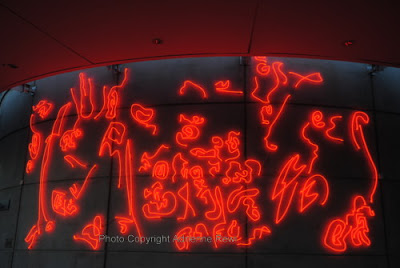 I couldn't have been happier when I discovered this neon sculpture by Paul Hartigan in the Faculty of Engineering at Auckland University, as I walked down Symonds Street one wintry afternoon recently. Everything that I love had come together in one place - interesting architecture, glass, art, old/new, skeletal trees and, best of all, a tangle of fascinating reflections - layer upon layer of image, form amd texture.
I couldn't have been happier when I discovered this neon sculpture by Paul Hartigan in the Faculty of Engineering at Auckland University, as I walked down Symonds Street one wintry afternoon recently. Everything that I love had come together in one place - interesting architecture, glass, art, old/new, skeletal trees and, best of all, a tangle of fascinating reflections - layer upon layer of image, form amd texture.


 I had already spent over an hour photographing the dynamic shapes and shadows of winter trees marching up the face of architecture old and new, so finding this whimsy of glowing red forms cavorting across the street and climbing the bare trees outside, was the perfect end to my street wander.
I had already spent over an hour photographing the dynamic shapes and shadows of winter trees marching up the face of architecture old and new, so finding this whimsy of glowing red forms cavorting across the street and climbing the bare trees outside, was the perfect end to my street wander.
 The work itself is Colony 2004
And Hartigan (b.1953) says the following in his concise artist statement:
The work itself is Colony 2004
And Hartigan (b.1953) says the following in his concise artist statement:"I made Colony to enhance and counterpoint the monumentalism of its site: the lecture theatre and surrounding buildings in the Faculty of Engineering. This expansive neon light drawing adds a sense of transition and movement to the space. Clustered elements radiate from a point, then travel towards the perimeter, morphing from semi-figurative motifs to abstract-surrealist gestures.

 "Rendered by my trademark graphic style, a synthesis of writing, pictographs and abstraction, the forms appear random, chaotic or free-form but are actually highly considered and carefully placed. The title suggests a collection of related entities with similar goals cohabitating in a new found territory. I chose neon gas for its vital 'living fire' quality. The incendiary persimmon colour of the tubes is the chromatic opposite of the tinted green glass encapsulating the space."
"Rendered by my trademark graphic style, a synthesis of writing, pictographs and abstraction, the forms appear random, chaotic or free-form but are actually highly considered and carefully placed. The title suggests a collection of related entities with similar goals cohabitating in a new found territory. I chose neon gas for its vital 'living fire' quality. The incendiary persimmon colour of the tubes is the chromatic opposite of the tinted green glass encapsulating the space."

 "Rendered by my trademark graphic style, a synthesis of writing, pictographs and abstraction, the forms appear random, chaotic or free-form but are actually highly considered and carefully placed. The title suggests a collection of related entities with similar goals cohabitating in a new found territory. I chose neon gas for its vital 'living fire' quality. The incendiary persimmon colour of the tubes is the chromatic opposite of the tinted green glass encapsulating the space."
"Rendered by my trademark graphic style, a synthesis of writing, pictographs and abstraction, the forms appear random, chaotic or free-form but are actually highly considered and carefully placed. The title suggests a collection of related entities with similar goals cohabitating in a new found territory. I chose neon gas for its vital 'living fire' quality. The incendiary persimmon colour of the tubes is the chromatic opposite of the tinted green glass encapsulating the space." I returned to this work three times while I was in Auckland, every time inspired again - not only for the way it so successfully captures the nature of its 'busy, colonised' environment but simply because I was so drawn to it and the way it appears to 'move and dance' away from its base, to fully interact with that environment via a set of ever-moving, ever-changing reflections. Lovely!




















 When I was in Wellington a few weeks ago, I sat outside Victoria University's Pipitea Campus, near Bunny Sreet and watched people coming and going, weaving their way through the four sculptures that make up
When I was in Wellington a few weeks ago, I sat outside Victoria University's Pipitea Campus, near Bunny Sreet and watched people coming and going, weaving their way through the four sculptures that make up 























